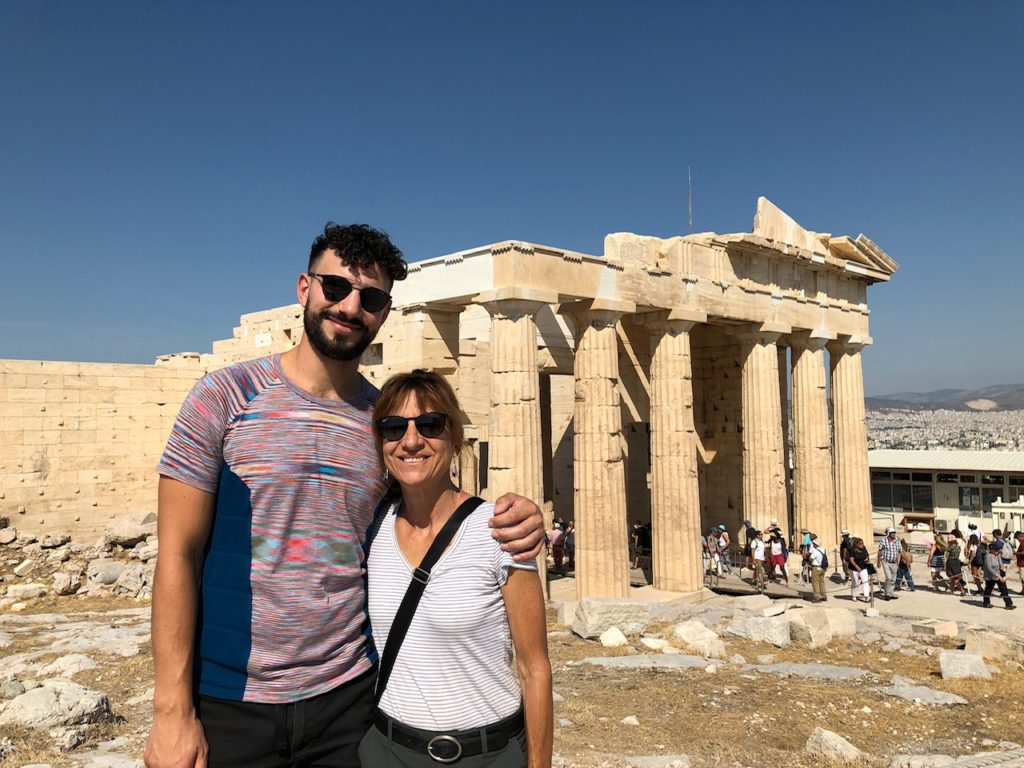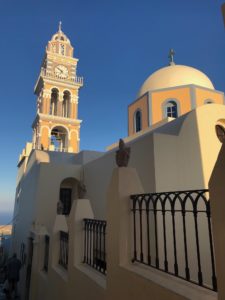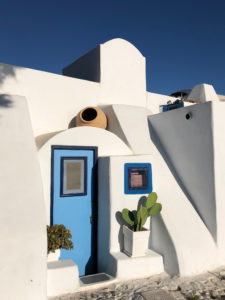 I first had the opportunity to travel to Greece when I was about 21. In the summer of 1981, as a graduation present from my father, I travelled around Europe. I met an art historian in Rome. It was the last stop in my journey, and he asked me, “You wanna go to Greece?”4
I first had the opportunity to travel to Greece when I was about 21. In the summer of 1981, as a graduation present from my father, I travelled around Europe. I met an art historian in Rome. It was the last stop in my journey, and he asked me, “You wanna go to Greece?”4
Of course, I wanted to go!
“I can’t,” I said. “I have to get a job.”
I didn’t go to Greece.
That was nearly 40 years and three kids ago. Last month I finally made the trek (the flight is longer than you think) with my son.
 Of course, we toured the architectural essentials: The Acropolis, the Parthenon, so many museums. Visiting the Palace of Knossos in Crete gave me chills, just knowing that the site was settled before 6,000 B.C. Many monuments and buildings were undergoing major structural repair. At these structures and even smaller spaces and residences, I saw the gold star of historic preservation. It also became obvious, while marveling at the layers of structures all over the islands, that I was seeing the bedrock of the fundamental rules of architecture.
Of course, we toured the architectural essentials: The Acropolis, the Parthenon, so many museums. Visiting the Palace of Knossos in Crete gave me chills, just knowing that the site was settled before 6,000 B.C. Many monuments and buildings were undergoing major structural repair. At these structures and even smaller spaces and residences, I saw the gold star of historic preservation. It also became obvious, while marveling at the layers of structures all over the islands, that I was seeing the bedrock of the fundamental rules of architecture.
The monumental history and beauty of Greece is matched, and balanced, by the people who inhabit the islands. Everywhere we went, locals implored us, “Relax.” Forever reminding us that it was time to slow down and take in the entire essence of their beloved sights. And to eat! The food in Greece is unreal. Stuffed eggplant, octopus, fresh sardines, tzatziki…I’m not a big eater but…there is nothing more important than food to my son. He would find places for us to eat and snack (the benefit of having a phone and a million food review apps), and we were never disappointed. We tried everything there was to try. I could taste the Turkish influences in the spices and preparation of the food. Wine is the least expensive thing on the menu, and it is good wine and plentiful.
 Color is also abundant. Everyone talks about the opulent blues and whites of Santorini, but to see it in “real life” is extraordinary. The sea is a canvas for the white stuccos and blue sky. There are no rules in the architecture there. Really modern design lives side-by-side with older structures, and there are layers of it, each trying hard to work with the landscape of that gem island.
Color is also abundant. Everyone talks about the opulent blues and whites of Santorini, but to see it in “real life” is extraordinary. The sea is a canvas for the white stuccos and blue sky. There are no rules in the architecture there. Really modern design lives side-by-side with older structures, and there are layers of it, each trying hard to work with the landscape of that gem island.
 Strangely, or perhaps naturally, there is no shortage of graffiti, especially in Athens. My son is a graffiti connoisseur, and he was immediately drawn to the street art, which was strongly cultural in the sense that the clandestine artists spray-painted modern renditions of gods and goddesses and other national touchstones on the stucco walls and marble columns and shop gates all over the city. It made me cringe a little…the ancient marble (there is marble EVERYWHERE) covered over with political messaging, obscenities, and graphic novel icons. Yet, it fits. The whole thing makes sense. New. Old. Modern. Classic. Ruined. Rebuilt.
Strangely, or perhaps naturally, there is no shortage of graffiti, especially in Athens. My son is a graffiti connoisseur, and he was immediately drawn to the street art, which was strongly cultural in the sense that the clandestine artists spray-painted modern renditions of gods and goddesses and other national touchstones on the stucco walls and marble columns and shop gates all over the city. It made me cringe a little…the ancient marble (there is marble EVERYWHERE) covered over with political messaging, obscenities, and graphic novel icons. Yet, it fits. The whole thing makes sense. New. Old. Modern. Classic. Ruined. Rebuilt.




